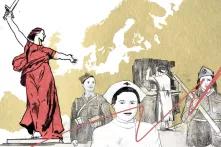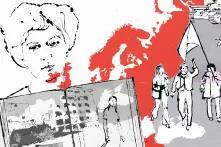of the 9th European History Forum - Hidden Remembrance? Women in the Second World War in Central, Eastern and South-Eastern Europe
On the second day of the European History Forum, four closed group discussions were held with participants from Central, Eastern and South-Eastern Europe. The aim of the discussions was to contribute to the deconstruction of the myths of heroines and their memory.
The European History Forum has set itself the goal of promoting European narratives that incorporate different perspectives and transcend national boundaries. One concern is to uncover neglected perspectives and stories. Since the dominant actors and decision-makers in history narratives are men, the theme of this year's forum was chosen to focus on women from Central, Eastern and Southeastern Europe in the Second World War. The forum aims to initiate an analysis of war and post-war history examining the role of women of all countries who took direct or indirect part in the war, and to which extent their great survival efforts, decisions and suffering could find a place in history and representations thereof.
To this end, four closed group discussions were held on the second day of the European History Forum with participants from Central, Eastern and South-Eastern Europe. The aim of the discussions was to contribute to the deconstruction of myths of heroines and their memory.
Group discussion 1: Role models on posters, in films and historical monuments: victims, heroines, what else?
On the basis of the analysis of various posters and their image of women before, during and after the war, the group concluded that women's emancipation was never an actual goal of official policy. Even if women were sometimes depicted in the posters in a heroic and emancipated manner, in the end this only applied within the framework of their family obligations. Instead, a patriarchal backlash followed the war was followed by a patriarchal backlash.
Monuments, for example, depict women as mothers who have lost their sons. Moreover, these monuments are generally not dedicated to the mothers or women, they tend to be monuments that represent the victory of war and loss of men-soldiers. It was further observed that the main theme after the war was the allegory of motherhood.
Group discussion 2: The image of women and woman role models in museums
In the conversation about the image of women and female role models in museums, the group found that women are generally misrepresented; they are often embellished rather than realistically portrayed.
Numerous suggestions for improvement were made during the discussion. For instance, exhibitions in museums should include a variety of experiences and voices, which includes the every-day life and the building of a complex picture of women role in the historic events. To that end, it is necessary to shift from frozen pictures to the documentation of women’s experience and to use storytelling. Finally, the reflection of the respective historic context and conditions was cited as key component for an effective deconstruction of myths, along with commenting on old patterns from today's perspective.
Group discussion 3: Yugoslav partisan women - ostracized, honored, forgotten?
To begin, the group noted that many facets of the subject area of Yugoslav partisan women are under-researched. The participants also noted that the top-down approach to history and history teaching leads to a commemoration culture determined and controlled by the governments. For example, heroines in post-Yugoslav countries were deliberately “forgotten” because of their communist beliefs and affiliations. In order to solve the problem of insufficient research, the participants highlighted the importance of regional and interdisciplinary cooperation and the involvement of student bodies and faculties as the next generation of researchers.
Group discussion 4: Women in the Red Army: Which memories and assessments are dominant?
Although up to one million women were in the Red Army in World War II, the films of victory parades after the war revealed that there is a total lack of representation for women soldiers – women are rather portrayed as symbols for the homeland and as the guardians of love.
The group concluded that it is important to look at women’s roles from the respective political or cultural context because the suppression of the women’s memory has changed throughout history. The group also recommended a comparative examination of the absence of women in different countries and wars. In order to counteract the suppression of women's memory, it is necessary to correct the false images of women conveyed in media and in the tradition of military or rural folklore.
Recommendations and future challenges:
- Increased focus on comparative and international research
- Consider intervention in exhibitions
- How to show the complexity and variety of women’s roles in the Second World War?
- How to obtain access to oral history sources and thus everyday life sources?
- How to engage experts that can guarantee a more equal gender representation to ensure that different gender perspectives are presented?
- How to involve political decision-makers on history education to change for example the picture of women in textbooks?
Das Veranstaltungsprotokoll wurde mit freundlicher Unterstützung von polisphere erstellt.

